|
||||||||||||||||||||||||||||||||||||||||||||||||||||||||||||||||||||||||||||||||||||||||||||||||||
Способ погребения |
Пол |
Предмет |
Материал |
Ингумация (мумия) |
Мужчина |
Шапка |
Мех |
Шуба верхняя |
Мех |
||
Шуба нижняя |
Мех |
||
Нагрудник |
Мех |
||
Две рукавицы |
Мех |
||
Штаны |
Мех |
||
Гетры? * |
Мех |
||
Пара сапожек |
Мех или кожа |
||
Детская шубка (подложена под плечи) |
Мех |
||
Ингумация (мумия) |
Женщина |
Шуба |
Мех |
Юбка |
Ткань |
||
Ингумация |
Ребёнок 6-7 лет |
– |
– |
|
Кремация (кукла 1) |
Мужчина ? |
Шуба |
Мех |
Штаны (часть левой штанины) |
Мех |
||
Остатки высоких носков |
Мех |
||
Сапожки |
Мех |
||
Кремация (кукла 2) |
Мужчина |
Шуба |
Мех |
Штаны |
Мех |
||
Принадлежность неясна (женская мумия, кукла 1 или кукла 2)** |
Шапка |
Мех |
|
(мумия мужчины или женщины?)*** |
Фрагменты неопределённого предмета состоящие из шерстяной ткани, сшитой с фрагментами меха |
Мех/кожа, ткань |
|
Примечания:
* Л.Р. Кызласов упоминает меховые «гетры» в полевом отчёте и публикациях (Кызласов Л., 1969а. С. 96; 1992. С. 66), но по неотреставрированному монолиту ног мумии сегодня судить о них трудно;
** В погребении шапка лежала у западной стенки сруба, между головой куклы 1 с одной стороны и головами женской мумии и лежащей под ней куклы 2 – с другой (Кызласов Л., 1969б. Л. 47);
*** Л.Р. Кызласов упоминает шерстяную ткань на колене мужской мумии «очевидно, от нижних штанов» (Кызласов Л., 1969б. Л. 43) и «обрывки меховых штанов» на тазе женской мумии (Там же. Л. 45). Возможно, с какими-то из этих находок и соотносятся имеющиеся в коллекции тканемеховые фрагменты.
швы шубы и рукавов (рис. 2, 5). Манжеты пришиты к рукавам и борта / воротник к полочкам / спинке швом через край с лица, что могло иметь декоративное значение. Так же сделаны швы по окату рукава и плечевые швы, но они при этом закрыты полосками кожи с подогнутыми краями. Интересно, что на плечевых швах это не просто полоски, а сужающиеся к рукавам своего рода «погоны», имеющие окончания в виде трехпалых лапок (рис. 1, 3; 2, 3). На обеих шубах эти «по-
Таблица 2. Данные о длине шуб и видовой принадлежности меха.
Table 2. Data about the length of fur coats and species of fur.
Способ захоронения |
Пол |
Мехом внутрь или наружу |
Принадлежность меха |
Длина, см |
№ рисунка |
Мумии |
Мужчина |
Наружу (верхняя шуба) |
Основа – северный олень. Оторочка – козёл? |
>106 Низ оборван |
3 |
Внутрь (нижняя шуба) |
Основа – овца (овца или домашний козёл). Оторочка – лайка или волк |
105-108* |
1 |
||
Мумия |
Женщина |
Внутрь |
Основа – коза или овца (домашний козёл). Оторочка – козёл (?). Воротник и борта – росомаха или медведь. Узкая полоска окантовки на вороте и бортах – лисица или соболь. |
>133 Низ оборван |
2 |
Кукла 1 |
Мужчина? |
Наружу |
Основа – узкие полоски шкурок с ног оленя, косули или сибирского козерога (косуля). Левая манжета – собака лайка |
92-95 |
4 |
Кукла 2 |
Мужчина ? |
Внутрь |
Основа – домашний козёл (чёрной и лимонной окраски), взрослый северный олень. Оторочка из собачьего меха (лайка). |
80-83 |
5 |
Принадлежность неизвестна (младенец) |
Внутрь |
Основа – овца. Пола – козёл. Оторочка – лайка или волк. Оторочка у ворота – соболь. |
40 |
6 |
|
Примечание:
* Примерная оценка длины связана с сильной деформацией и складчатым характером кожи шуб.
гончики» соединяются на спине в узкую кокетку (рис. 1, 5).
Воротники обеих шуб двойные (внутренний слой меховой, внешний – из толстой кожи). При этом борта – одинарные, продолжающие полосу меха, спускающуюся с ворота. Воротники мужской и женской шуб скроены из трёх основных деталей: по три полосы кожи или меха сшиты торцами в огибающий шею ворот. На женской шубе стыки между тремя фрагментами на меховой и кожаной сторонах совпадают; кроме того, они расположены на одной линии с передним краем «погончиков». На мужской шубе места соединения трёх фрагментов видны только на внутренней, некогда меховой стороне (рис. 1, 4, красные стрелки), тогда как на кожаной стороне возможные места стыков закрыты рельефными фигурами, напоминающими стилизованные бутоны на стеблях (рис. 1, 2, 5). Пять таких фигур расположены симметрично на вороте, на равном расстоянии друг от друга. Положение второго и четвёртого «бутонов» соответствует переднему краю «погон» (рис. 1, 5) и стыкам внутренней части ворота: значит, подобно женской шубе, здесь могут располагаться стыки трёх составляющих внешней стороны ворота.
На внутренней стороне ворота мужской шубы сделаны вытачки: пять на центральном фрагменте и по четыре на боковых (рис. 1, 4). Идущие снизу
[Рис. 1]
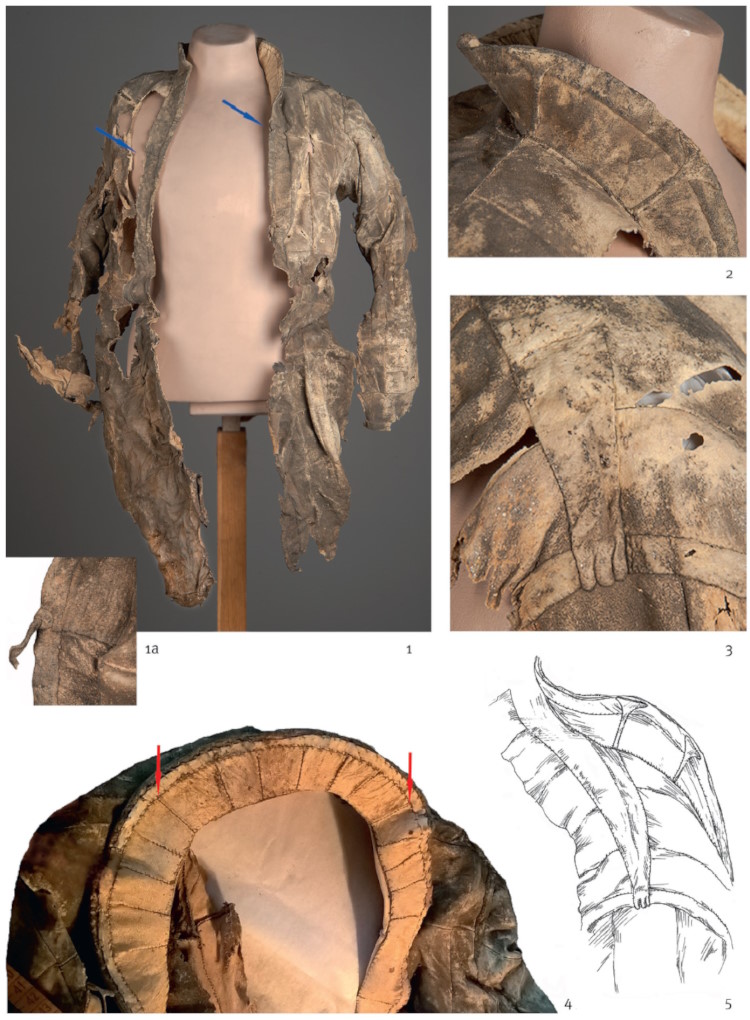
Рис. 1. Нижняя шуба мужской мумии (мехом внутрь). Мех, кожа. 1 – общий вид (синие стрелки указывают на завязки); 1а – обрывок завязки на левой поле; 2 – ворот с аппликациями в виде «бутонов»; 3 – «погон» правого плеча с трёхпалой лапкой; 4 – внутренняя сторона воротника: стыки и вытачки, окантовка узкой полоской меха (красные стрелки указывают на стыки / соединительные швы трёх частей ворота); 5 – правое плечо шубы с «кокеткой» и «погоном» с лапкой, ворот с аппликациями-«бутонами». 1, 2 – фото К. Синявского; 3, 4 – фото автора; 5 – рисунок А.О. Машезерской.
Fig. 1. The underwear fur coat of a male mummy (fur inside). Fur, leather. 1 – general appearance (blue arrows point to the strings); 1а – scraps of a string on the left field; 2 – collar with appliqués in the form of ‘buds’; 3 – ‘shoulder strap’ of the right shoulder with a three-finger leg; 4 – internal side of the collar: joints and tucks, fringe of a narrow band of fur (red arrows point to the joints/connecting seams of the three parts of the collar); 5 – right side of the fur coat with a yoke and a ‘shoulder strap’ with a leg, collar with appliqués in the form of ‘buds’. 1, 2 – photo by K. Sinyavskiy; 3, 4 – photo by the author; 5 – drawing by A.O. Mashezerskaya.
вверх, они немного не доходят до внешнего края ворота, чем и отличаются от стыковочных швов. Вытачки, видимо, служили для придания вороту вертикального положения.
Ещё одна интересная особенность мужской и женской шуб скрыта под «кокеткой» с окончаниями-лапками (рис. 2, 3; 1, 5) и видна только изнутри. Плечевые швы шуб соединяются позади ворота, образуя прямую горизонтальную линию верха спинки. По центру этого шва, между ним и воротом каждой шубы, вшита миниатюрная трапециевидная деталь, размерами 16×1,5 см у мужской шубы и 15×1 см у женской.
На обеих шубах сохранились обрывки кожаных ремешков-завязок у нижнего края ворота: с обеих сторон у мужской шубы (рис. 1, 1, синие стрелки, 1а) и слева у женской (участок правого борта в месте вероятной завязки разрушен) (рис. 2, 1, синяя стрелка, 1а). Завязки на левой стороне обеих шуб расположены у самого края борта, тогда как парная завязка на правой стороне мужской шубы пришита глубже, на стыке борта с полочкой (рис. 1, 1). Это позволяет предполагать, что полы завязывались не встык, как предполагали ранее (Завитухина, 1976. С. 101; Вадецкая, 1999. С. 54-57), а внахлёст слева направо.
Так же расположены и парные отверстия под воротом второй, внешней шубы мужской мумии, в которых можно предполагать следы от утраченных завязок (рис. 3, 1, 3, синие стрелки). Это округлые отверстия диаметром около 1 см: на левом борту отверстие расположено у его внешнего края, на правом – у стыка борта с полочкой. Деформация кожи вокруг отверстий, которая отогнута наружу, причём наиболее сильно на обращённых друг к другу сторонах обоих отверстий, могла произойти от регулярного натяжения продетых в отверстия ремешков-завязок.
Воротник этой шубы также скроен из трёх частей (рис. 3, 3, красные стрелки) и также имеет вытачки для придания вороту стоячего положения (рис. 3, 2, 3). Вытачки сделаны по поперечным надрезам от нижнего края ворота: четыре на центральном фрагменте и по две на боковых. Однако воротник этой шубы однослойный.
Внешняя шуба мужской мумии в целом отличается от ранее описанных рядом особенностей. Во-первых, она сшита мехом наружу. Во-вторых, её полочки, рукава и, видимо, спинка (сохранилась лишь в самом верху) сшивались не из вертикальных полос, набранных из прямоугольных деталей, а из горизонтальных ярусов, сшитых из узких вертикальных полосок, размерами около 22×5 см. В-третьих, для соединения всех частей шубы использованы швы лишь одного вида – через край с изнанки. Отсутствуют узкие оторочки на вороте, бортах и манжетах. Нет полосок, закрывающих швы по окату рукава, нет декоративных деталей. О клиньях у боковых швов из-за сохранности шубы данных нет; на единственном сохранившемся рукаве клинья расположены не симметрично: по одному, с разных сторон шва, на уровне разных ярусов рукава. У этой шубы особенно много зашитых разрывов и аккуратно пришитых с оборота заплаток.
Насколько принципиальны отличия описанных шуб мумий? Создаётся впечатление, что определяющее значение имело то, куда обращён мех – внутрь или наружу. Его направление могло быть связано с более конкретным назначением предмета одежды и влиять на способы его изготовления. Вполне логично, что нижняя шуба обращена мехом к телу – так теплее. Также и отсутствие декоративных деталей («бутоны», «погоны» с лапкой) на внешней шубе могло определяться её густой меховой поверхностью.
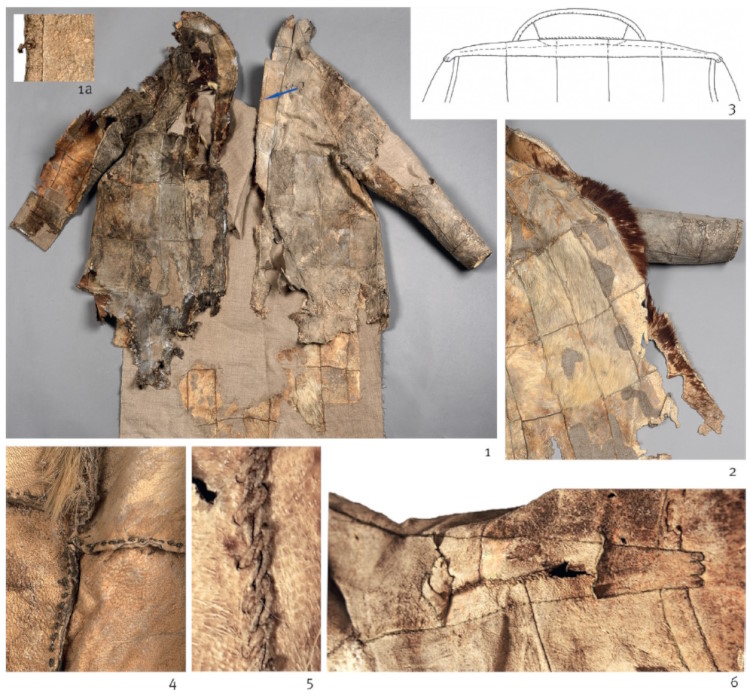
Рис. 2. Шуба женской мумии мехом внутрь. Мех, кожа. 1 – общий вид (синяя стрелка указывает на завязку); 1а – обрывок завязки на левой поле; 2 – левая полочка изнутри; 3 – детали плечевой части шубы, вид со спины: шов верха спинки и трапециевидной детали (показаны пунктиром) и закрывающая их «кокетка»; 4 – шов «вперед иголка» по основанию отогнутых краёв; 5 – шов через край с изнанки; 6 – «погон» левого плеча с трехпалой лапкой. 1, 2, 4 – фото К. Синявского; 5, 6 – фото автора; 3 – рисунок А.О. Машезерской.
Fig. 2. Fur coat of a female mummy (fur inside). Fur, leather. 1 – general appearance (blue arrow points to the string); 1а – scrap of a string on the left field; 2 – left fillet on inside; 3 – parts of the shoulder of the fur coat, view from the back: seam of the top of the back and trapezoid part (shown in dotted line) and the yoke covering them; 4 – seam ‘needle forwards’ along the base of the everted edges; 5 – seam over the edge on the inner side; 6 – ‘shoulder strap’ of the left shoulder with a three-finger leg. 1, 2, 4 – photo by K. Sinyavskiy; 5, 6 – photo by the author; 3 – drawing by A.O. Mashezerskaya.
Интересно, что шуба куклы 1, также сшитая мехом наружу, имеет ряд сходств с описанной верхней шубой мужской мумии (рис. 4). Она сшита из горизонтальных ярусов, собранных из узких вертикальных полосок меха (рис. 4, 3). При её изготовлении использован лишь один тип шва – через край с изнанки или встык. Соответствующие друг другу ярусы левого и правого рукавов (всего по три) имеют разную высоту, т.е. были асимметричны, однако, возможно, это было незаметно в густом меху. Манжеты при этом сделаны из контрастного меха: правый – светлый, левый – тёмный.
Ворот однослойный, оторочек нет. Боковые клинья в рукавах отсутствуют (под мышками шуба не
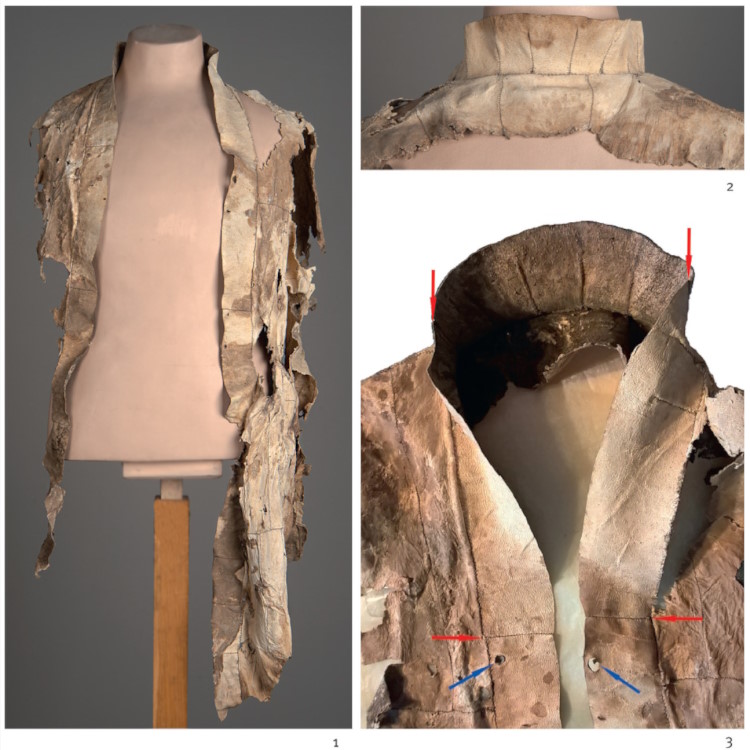
Рис. 3. Верхняя шуба мужской мумии (мехом наружу). Кожа (ворс выпал). 1 – общий вид; 2 – воротник, вид сзади; 3 – воротник и верхняя часть бортов (красные стрелки указывают на стыки / соединительные швы трёх частей ворота; синие стрелки указывают на отверстия, оставшиеся, вероятно, от завязок). 1, 2 – фото К. Синявского; 3 – фото автора.
Fig. 3. Upper fur coat of a male mummy (fur out). Leather (the nap fallen out). 1 – general view; 2 – collar, view from behind; 3 – collar and the top part of the edge (red arrows point to joints / connecting seams of the three parts of the collar; blue arrows point to holes left probably from the strings). 1, 2 – photo by K. Sinyavskiy; 3 – photo by the author.
сохранилась). Однако ярусы соединяются не встык, как у верхней шубы мумии, а внахлёст, с перекрыванием нижних полос верхними на 2-3 см. Воротник, сохранившийся слева на одну треть, сшит из прямоугольных кусочков в 3-4 и 8-9 см длиной (рис. 4, 3).
Под воротом у внешнего края левого борта сделана горизонтальная прорезь, в которую вставлен и завязан плоский кожаный ремешок – завязка (рис. 4, 2, 3, синие стрелки). По низу шубы шла полоса окантовки шириной около 2,5 см (рис. 4, 1).
Укороченная шуба куклы 2 сшита мехом внутрь и во многом сходна с шубами мумий, сшитыми так же. У неё двухслойный ворот, его внутренняя сторона меховая, а внешняя кожаная, украшенная пятью рельефными «бутонами» (рис. 5, 1-3). Позади ворота есть трапециевидная деталь, к которой при-
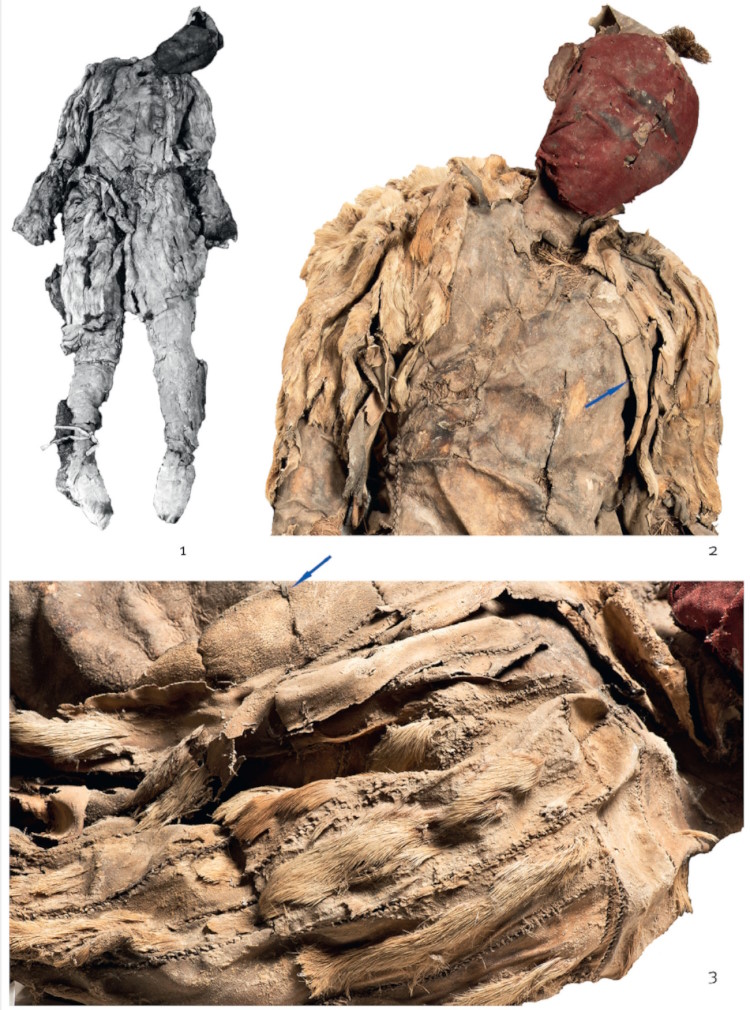
Рис. 4. Шуба куклы 1. Мех. 1 – общий вид куклы; 2 – общий вид верхней части шубы спереди (синяя стрелка указывает на завязку); 3 – левое плечо и верх рукава, воротник и часть борта с завязкой. 1 – фото 1969 г.; 2, 3 – фото П.С. Демидова.
Fig. 4. Fur coat of mannequin 1. Fur. 1 – general view of the mannequin; 2 – general view of the upper part of the fur coat in the front (the arrow points to a string); 3 – left shoulder and the top of the sleeve, collar and part of the edge with a string. 1 – photo of 1969; 2, 3 – photo by P.S. Demidov.
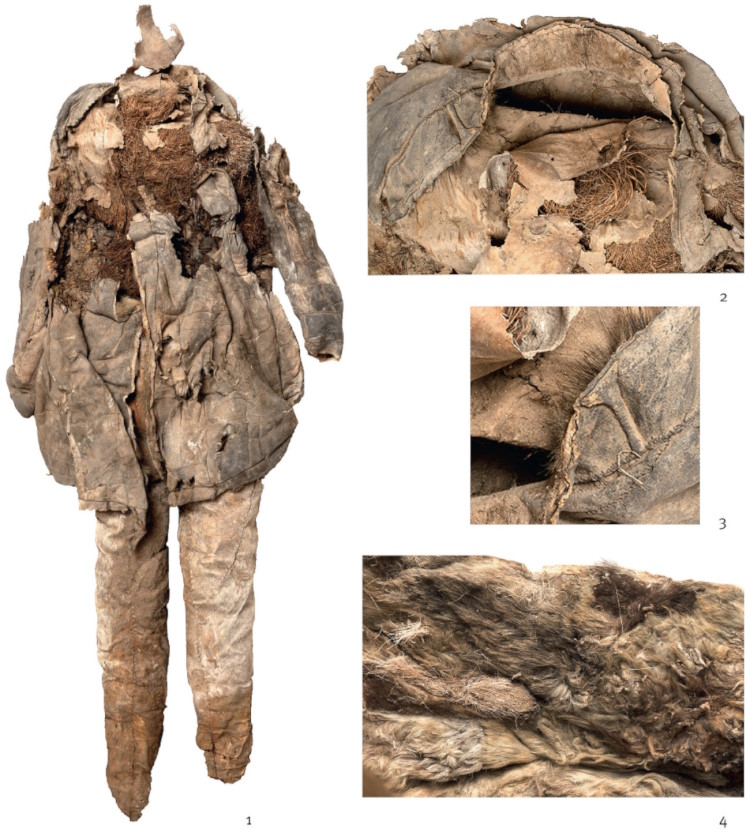
Рис. 5. Шуба куклы 2 (мехом внутрь). Мех. 1 – общий вид; 2, 3 – воротник с аппликациями; 4 – мех на левой полочке. Фото К. Синявского.
Fig. 5. Fur coat of mannequin 2 (fur inside). Fur. 1 – general view; 2, 3 – collar with applications; 4 – fur on the left fillet. Photo by K. Sinyavskiy.
мыкает горизонтальная линия верха спинки. Швы шубы отличаются для разных её деталей: мелкие фрагменты сшиты швом «вперёд иголка» по основанию отогнутых краёв, крупные – швом через край (боковые швы, швы пришива манжет, бортов, ворота и полосы окантовки низа). На вороте, манжетах и бортах есть узкие полоски окантовки.
Вместе с тем очевидны и отличия. Во-первых, способ набора «полотна» этой шубы не имеет видимой системы. Фрагменты, составляющие шубу, совершен-
но различны: от крупных прямоугольных кусков до мелких фрагментов разной формы, видимо составленных изначально в бо́льшие детали – разновеликие полосы и клинья, а затем соединённых в полочки. Во-вторых, клиновидные фрагменты вставлены также скорее произвольно: в передних полах шубы имеются по 1-2 клиновидных фрагмента, сделанных как будто с учётом необходимости расширения шубы книзу. Вместе с тем в правой полочке присутствует и клиновидный фрагмент обратного направления. У бокового шва со стороны полочки вставлен клиновидный фрагмент меха, но с противоположной стороны шва симметричного клина нет. Однако на сохранившейся части спинки видна тенденция её набора из вертикальных полос, составленных из фрагментов.
Передние полы шубы имеют очевидное удлинение к центру. Низ ворота и верх бортов утрачены, как и вероятные для этих участков шубы завязки.
Детально проработанный воротник заслуживает отдельного внимания. На внутренней стороне сохранившейся части ворота имеются семь поперечных стыковочных швов (1-7, считая c левой стороны вокруг шеи), т.е. эта сторона была собрана из прямоугольных фрагментов длиной от 6 до 9,5 см. Пять фигур-«бутонов» на внешней стороне ворота в целом соответствуют местам стыковочных швов внутренней стороны ворота (от 2-го до 6-го). На участках, где сшивка слоёв ворота разошлась, удалось выяснить, что часть «бутонов» действительно закрывает стыки деталей наружного ворота, а другие – пришиты на участок без стыка. Стык под вторым слева «бутоном» соответствует месту стыковки деталей трёхчастных воротников на других шубах. Значит, внешняя сторона ворота куклы 2 также могла быть скроена из трёх основных частей – эта особенность выглядит уже стандартной для оглахтинских шуб. Однако нет вытачек.
Шуба куклы 2 по многим признакам подобна шубам мумий с мехом внутрь. Её отличие от них – меньшая длина, разнородность исходных фрагментов и отсутствие симметрии в расположении боковых клиньев.
Детская шубка очень похожа на взрослые, хотя и отличается рядом особенностей. Она сшита мехом внутрь и, подобно таким же шубам мумий, имеет симметричные клинья у боковых швов. Ворот, борта и манжеты оторочены узкими полосками меха. Подобно шубе куклы 2, полы детской шубки скошены и удлиняются к центру, однако нижняя полоса окантовки здесь отсутствует (рис. 6).
Швы соединения большинства фрагментов одинаковые – через край с изнанки. Отличаются только швы набора ворота и борта и шов их пришивки к полочкам – через край с лица. Похоже, эти рельефные швы выполняли и декоративную функцию, т.к. хорошо выделяются на поверхности кожи в передней части шубки.
Спинка, миниатюрные рукава и большие части полочек сделаны из цельных фрагментов меха (полочки надставлены снизу дополнительными фрагментами); возможно, это определяется небольшими размерами шубки. То же можно предположить относительно однослойного ворота: двойной воротник был бы излишне тяжёлым для такого миниатюрного предмета. Судя по расположению двух поперечных швов на вороте – по сторонам от шеи, – воротник кроился из трёх фрагментов, подобно воротникам большинства шуб взрослых. Завязки отсутствуют.
Плечевые швы шубки смещены назад и соединяются за воротом в одну линию, совпадающую с горизонтальным краем верха спинки. По центру спинки, под воротником расположена миниатюрная трапециевидная деталь, сужающаяся книзу (рис. 6, 2, стрелка). Такие же детали, как было сказано, присутствуют и на шубах взрослых, сшитых мехом внутрь (только у мужской и женской мумий они скрыты пришитыми снаружи «кокетками» с окончаниями-лапками). Отличие оформления детской шубки в том, что во все эти швы – горизонтальный шов верха спины, боковые швы трапециевидной детали, швы оката рукавов – проложены согнутые вдвое полоски кожи.
На шубке несколько аккуратных округлых заплат, поставленных снаружи. Благодаря им, а также из-за тщательности исполнения шубка производит впечатление реально носимого предмета одежды.
По многим признакам детская шубка сшита аналогично взрослой одежде: общий покрой со стоячим воротом и бортом; пошив ворота из трёх деталей; смещённые плечевые швы и трапециевидная деталь под воротом; отделка бортов и ворота; скошенные к центру полы. Некоторые отличия этой шубки могли быть связаны с её миниатюрными размерами: цельный характер полочек и спинки, однослойность воротника, отсутствие завязок.
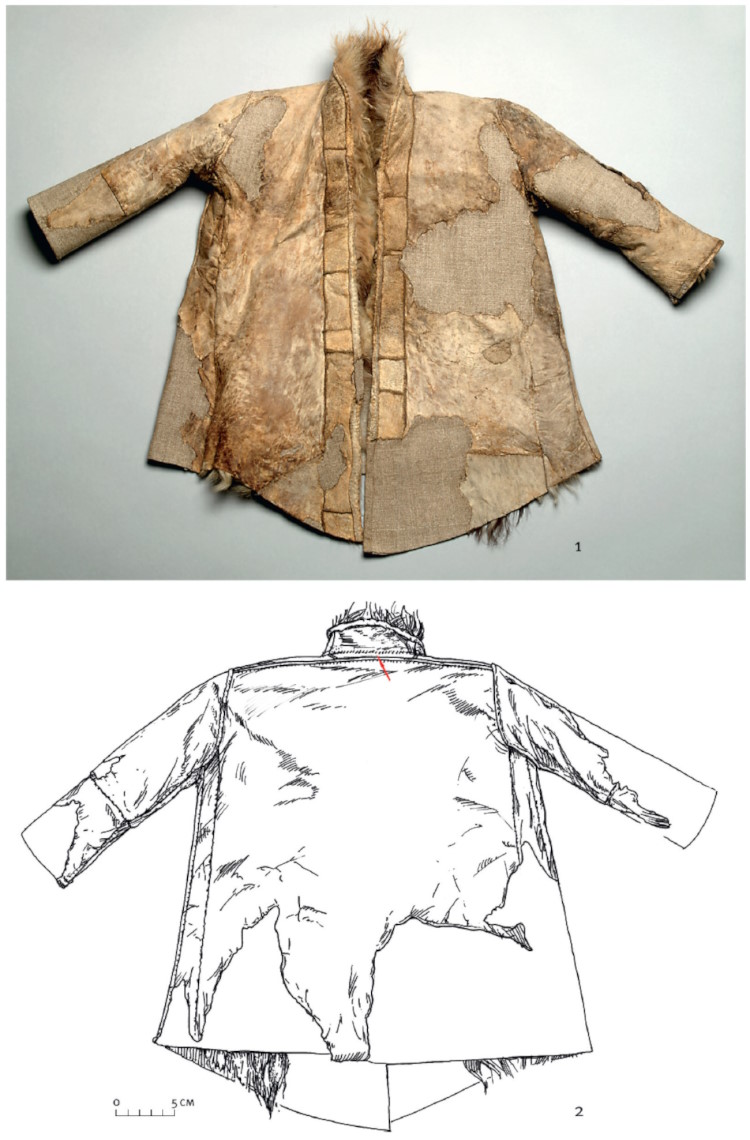
Рис. 6. Детская шубка (мехом внутрь). Мех. 1 – общий вид спереди; 2 – вид сзади (красная стрелка указывает на трапециевидную деталь). Фото В.С. Теребенина. Рисунок А.О. Машезерской.
Fig. 6. Child’s fur coat (fur inside). Fur. 1 – general view from the front; 2 – view from behind (red arrow points to a trapezoid detail). Photo by V.S. Terebenin. Drawing by A.O. Mashezerskaya.
Хотя в могиле 4 похоронен ребёнок, шубка вряд ли имела к нему отношение, как было сказано, по размеру она подходит разве что младенцу, к тому же была подложена под плечи мужчины. В могильниках на востоке Таримского бассейна, где хорошо сохранилась органика, известны примеры помещения вотивных кафтанчиков со взрослыми погребёнными (Bao, 1989. Р. 5; Wieczorek, Lind, 2007. Р. 249, 260, Cat. 148, 162). Возможно, эти случаи чем-то аналогичны нашему. Но оглахтинская шубка могла быть и детской одеждой погребённого мужчины, которую хранили в течение жизни в его семье и похоронили вместе с ним.
Подводя итоги краткого рассмотрения шуб из могилы 4 Оглахтинского могильника, можно отметить, что все они имеют характерный узнаваемый покрой и включают такие детали, как вертикальный ворот, сшитый из трёх частей и переходящий в борта, и пара завязок у основания ворота. Рукава всех шуб обрамлены манжетами, а сохранившийся нижний край подола – полосой окантовки.
Все взрослые шубы сшиты из фрагментов и изготовлялись, похоже, по определённым правилам, набор которых определялся прежде всего направлением волоса шкуры – внутрь или наружу. Шубы, сшитые мехом к телу, изготовлены с бо́льшим числом деталей, и разные категории деталей соединены с помощью определённых видов швов. У таких шуб двойные воротники, окантованные, как и борта и манжеты, узкими полосками меха. На кожаной поверхности шуб – декоративные детали в виде фигурных аппликаций и внешних швов; отдельные швы закрыты полосками кожи. Шубы мумий мехом внутрь сшиты из вертикальных полос, набранных из одинаковых прямоугольных фрагментов; у боковых швов вшиты симметричные клинья. Последняя особенность отличает и детскую шубку. У неё и шубы куклы 2 полы скошены к центру. Эта деталь неожиданно напомнила подобную особенность плечевой одежды скифов, изображённых на элитных предметах торевтики (Алексеев, 2012. С. 134 [гребень, Солоха], 154-155 [сосуд со сценой охоты, Солоха], 160-161 [нашивные бляшки со сценой питья из рога, Солоха], 186 [всадник на гривне, Куль-Оба], 194, 198-199 [Чертомлыкская амфора] сл.). Интересно, что кафтаны с подобными полами представлены также на керамической плитке с городища Кафыр-Кала в Таджикистане VIII в. (Соловьёв, 1991. С. 271; Филимонова, Сайфулоев, 2019. Обложка).
Шубы мехом наружу составлены из горизонтальных ярусов, набранных из узких вертикальных полосок. Использован лишь один вид швов, ворот однослойный, нет окантовок и декоративных деталей. Менее выражены клинья для расширения шуб книзу и рукавов в плечах.
Женская шуба сделана длиннее и шире мужских, а в остальном – практически одинаково. Только на мужских шубах имеются декоративные детали-«бутоны», тогда как «погоны» с лапками встречены только на шубах мумий (мужской и женской). Для выраженного вертикального положения на воротниках шуб мужской мумии сделаны вытачки. Детская шубка обладала определённой спецификой, отчасти, видимо, связанной с её миниатюрными размерами. При этом отличия принципиального характера в изготовлении шуб женщин и мужчин, мумий и кукол, взрослых и детей пока не просматриваются.
Внутренняя мужская и женская шубы сделаны наиболее тщательно и детально. Внешняя мужская и детская, а также шубы обеих кукол отличаются большим количеством починок – заплатки и штопки разрывов. Шуба куклы 1 выглядит несколько упрощённой по конструкции, в рукавах и манжетах отсутствует симметрия, так что нельзя исключить, что она могла быть сшита для посмертного использования. Для других оглахтинских шуб таких сомнений не возникает: все они производят впечатление используемых при жизни.
На большинстве шуб сохранились завязки, размещённые под воротом. Их расположение позволяет предполагать, что шубы запахивались слева направо. Завязки имеются также на шапках, юбке, штанах и сапожках из оглахтинской коллекции: широкое использование завязок было, вероятно, одной из характерных черт костюма населения Минусинской котловины раннеташтыкского времени.
При рассмотрении оглахтинских шуб стало ясно, что многие особенности пошива связаны с причинами функционального, антропометрического и технологического характера, и далеко не все они могут считаться культурно или гендерно показательными. При дальнейшем изучении оглахтинских меховых предметов стоит обратиться к технологам или портным, так как некоторые особенности деталей этой одежды могли быть связаны с повышением её комфортности и долговечности.
Алексеев, 2012 – Алексеев А.Ю. Золото скифских царей в собрании Эрмитажа. СПб.: Изд-во Гос. Эрмитажа, 2012. 272 с.
Вадецкая, 1999 – Вадецкая Э.Б. Таштыкская эпоха в древней истории Сибири. СПб.: Петербургское востоковедение, 1999. 400 с. (Archaeologica Petropolitana. VII).
Готлиб и др., 2003 – Готлиб А.И., Зубков В.С., Поселянин А.И., Худяков Ю.С. Археология Хакасско-Минусинского края. Абакан: Изд-во Хакасского гос. ун-та им. Н.Ф. Катанова, 2003. 223 с.
Завитухина, 1976 – Завитухина М.П. Хуннский период / Древняя Сибирь. Путеводитель по выставке «Культура и искусство древнего населения Сибири. VII век до н.э. — XIII век н.э.» [Эрмитаж] Л.: Аврора, 1976. С. 89-112.
Кызласов Л., 1969а – Кызласов Л.Р. Кто жил в Хакасии две тысячи лет назад? // Наука и жизнь. 1969. №12. С. 93-97.
Кызласов Л., 1969б – Кызласов Л.Р. Отчёт о работе Хакасской археологической экспедиции Московского государственного университета в 1969 г. // НОА ИА РАН. Р-1, №4010.
Кызласов Л., 1970 – Кызласов Л.Р. Раскопки в Оглахтах // АО 1969 года. М.: Наука, 1970. С. 197-199.
Кызласов Л., 1992 – Кызласов Л.Р. Очерки по истории Сибири и Центральной Азии. Красноярск: Изд-во Красноярского ун-та, 1992. 224 с.
Никитина, Баранова, 1973 – Никитина К.Ф., Баранова Т.А. Опыт реставрации сухого археологического меха // СГЭ. 1973. Вып. XXXVII. С. 78-79.
Панкова, 2005 – Панкова С.В. Композитная юбка из могильника Оглахты в Южной Сибири // VI конгресс этнографов и антропологов России. Санкт-Петербург, 28 июня — 2 июля 2005 г. ТД. 2005. С. 159-160.
Панкова и др., 2010 – Панкова С.В., Васильев С.С., Дергачёв В.А., Зайцева Г.И. Радиоуглеродное датирование оглахтинской гробницы методом ‘wiggle matching’// АЭАЕ. 2010. №2 (42). С. 46-56.
Соловьёв, 1991 – Соловьёв В.С. Керамическая плитка из Кафыркалы // СА. 1991. №3. С. 270-272.
Филимонова, Сайфулоев, 2019 – Филимонова Т.Г., Сайфулоев Н.Н. Археологическая карта Таджикистана. Район Джалолиддина Балхи. Душанбе: Институт истории, археологии и этнографии АН РТ, 2019. 108 с.
Bao, 1989 – Bao M. Cemeteries on the outskirts of Loulan, China // Archaeological Textile Newsletter. 1989. Is. 8. P. 4-5.
Nikolaev, Pankova, 2017 – Nikolaev N., Pankova S. After the Scythians // Scythians: warriors of ancient Siberia / Eds. St J. Simpson, S. Pankova. London: The British Museum; Thames and Hudson, 2017. P. 322-351.
Pankova, in print – Pankova S. Mummies and mannequins from the Oglakhty cemetery in Southern Siberia // Masters of the steppe: the impact of the Scythians and later nomad societies of Eurasia. Proceedings of a conference held at the British Museum, 27-29 October 2017 / Eds. St J. Simpson, S. Pankova. London: Archaeopress. In print.
Wieczorec, Lind, 2007 – Wieczorek A., Lind C. (Eds.). Ursprünge der Seidenstraße. Sensationelle Neufunde aus Xinjiang, China. Stuttgart. 320 S.
Zavitukhina, Barkova, 1978 – Zavitukhina M.P., Barkova L.L. Frozen Tombs. The culture and art of the ancient tribes of Siberia. Exhibition catalogue. London: British Museum, 1978. 102 p.
^ Fur clothes from the cemetery of Oglakhty: coats from burial no. 4.
S.V. Pankova
Burials of the Tashtyk flat-grave cemetery of Oglakhty in Khakasia are interesting both in the well preserved objects from organic materials and in a peculiar funerary practice: in the graves, interments according to the inhumation rite with trepanised skulls (mummies) and cremations placed in leather-grass dolls (funerary mannequins) are neighbouring. In grave no. 4 (3rd-4th century), the male and female mummies and mannequins are dressed in fur clothes: caps, coats, bibs, mittens, trousers, socks/stockings and boots (Table 1). In this paper, a brief review of these materials is presented; however the main attention is paid to findings of six fur coats belonging to different categories of the interred (Table 2; Fig. 1-6). Analysis of the peculiarities of the cut of the fur coats and techniques of their sewing draws to the conclusion that the greatest differences are between the coats sewn fur inside and those with fur out. There are also certain differences between the furs coats belonging to mummies and mannequins, males and females, children and adults, but these distinctions seem to be much less pronounced.
[1] 190000, Россия, Санкт-Петербург, Дворцовая наб., д. 34. Государственный Эрмитаж, Отдел археологии Восточной Европы и Сибири. […]
[2] Изучение шуб проходит одновременно с нелёгкой работой по их зарисовке и при непосредственном участии А.О. Машезерской. Искренне благодарю её за это.
[3] Определение Л.Р. Кызласова (Кызласов Л., 1969б. Л. 42). Скелет ребёнка сохранился плохо, одежда при нём не обнаружена.
[4] Благодарю с.н.с. Отдела антропологии МАЭ РАН к.и.н. И.Г. Широбокова за возможность сослаться на результат неопубликованного исследования.
[5] Приведены данные, включённые в «Результаты определений шкур пушных зверей на одежде трупов и кукол из могилы Оглахты VI < … > раскопок проф. Л.Р. Кызласова» от 27.01.1970 г. Курсивом отмечены определения, отсутствующие в названном документе, но обнаруженные в рукописи из личного архива Н.К. Верещагина в ЗИН РАН. Благодарю с.н.с. Лаборатории териологии ЗИН РАН, к.б.н. М.В. Саблина за помощь при работе с этим архивом.
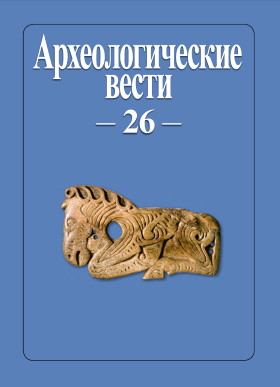 С.В. Панкова
С.В. Панкова